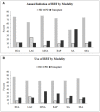The gap between estimated incidence of end-stage renal disease and use of therapy
- PMID: 24023651
- PMCID: PMC3758352
- DOI: 10.1371/journal.pone.0072860
The gap between estimated incidence of end-stage renal disease and use of therapy
Abstract
Background: Relatively few data exist on the burden of end-stage renal disease (ESRD) and use of renal replacement therapy (RRT)-a life-saving therapy-in developing regions. No study has quantified the proportion of patients who develop ESRD but are unable to access RRT.
Methods: We performed a comprehensive literature search to estimate use and annual initiation of RRT worldwide, and present these estimates according to World Bank regions. We also present estimates of survival and of etiology of diseases in patients undergoing RRT. Using data on prevalence of diabetes and hypertension, we modeled the incidence of ESRD related to these risk factors in order to quantify the gap between ESRD and use of RRT in developing regions.
Results: We find that 1.9 million patients are undergoing RRT worldwide, with continued use and annual initiation at 316 and 73 per million population respectively. RRT use correlates directly (Pearson's r = 0.94) with regional income. Hemodialysis remains the dominant form of RRT but there is wide regional variation in its use. With the exception of the Latin American and Caribbean region, it appears that initiation of RRT in developing regions is restricted to fewer than a quarter of patients projected to develop ESRD. This results in at least 1.2 million premature deaths each year due to lack of access to RRT as a result of diabetes and elevated blood pressure and as many as 3.2 million premature deaths due to all causes of ESRD.
Conclusion: Thus, the majority of patients projected to reach ESRD due to diabetes or hypertension in developing regions are unable to access RRT; this gap will increase with rising prevalence of these risk factors worldwide.
Conflict of interest statement
Figures




References
-
- Wild S, Roglic G, Green A, Sicree R, King H (2004) Global prevalence of diabetes: estimates for the year 2000 and projections for 2030. Diabetes Care 27: 1047–1053. - PubMed
-
- Kearney PM, Whelton M, Reynolds K, Muntner P, Whelton PK, et al. (2005) Global burden of hypertension: analysis of worldwide data. Lancet 365: 217–223. - PubMed
-
- Barsoum RS (2006) Chronic kidney disease in the developing world. N Engl J Med 354: 997–999. - PubMed
-
- Jha V (2004) End-stage renal care in developing countries: the India experience. Ren Fail 26: 201–208. - PubMed
Publication types
MeSH terms
Grants and funding
LinkOut - more resources
Full Text Sources
Other Literature Sources
Medical
Miscellaneous

